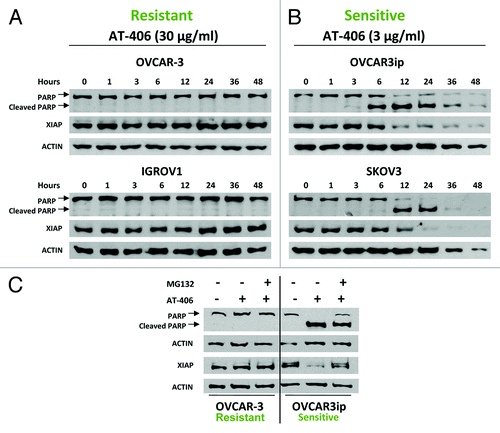Figures & data
Figure 1. XIAP is upregulated in human ovarian cancer. (A) XIAP levels in human ovarian cancer and normal ovary were assessed by immunohistochemistry using anti-human XIAP antibody (R&D). (B) Endogenous XIAP, cIAP1, Caspase-3, Caspase-8, and Caspase-9 expression in a panel of human ovarian cancer cell lines was determined by western blotting with anti-XIAP (Santa Cruz), -cIAP1, Caspase-3, -Caspase-8, or -Caspase-9 (Cell Signaling) antibodies. Actin (Neomarkers) was used as a loading control.

Figure 2. AT-406 displays single agent activity in ovarian cancer cell lines. (A) Eight human ovarian cancer cell lines were treated for 48 h with increasing doses of AT-406 as depicted in the graphs. (B) Graphical representation of the cell viability curves for all eight ovarian cancer cell lines distinguishing AT-406 sensitive vs. insensitive cell lines. (C) OVCAR-3ip ovarian cancer cell line was treated with increasing doses of AT-406 for 24 h as indicated in the figure. Cells were lysed and probed for cleaved-PARP levels by western blotting. Actin was used as a loading control.
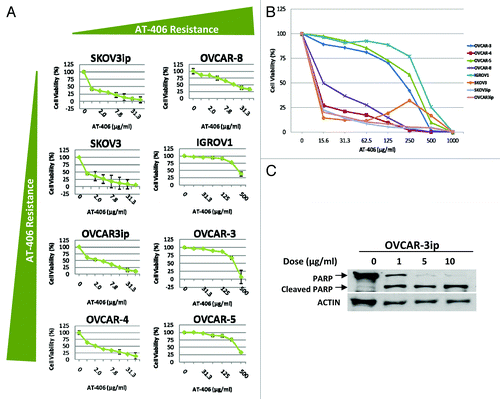
Figure 3. A panel of human ovarian cancer cells displays a range of IC50 to carboplatin. (A) Eight human ovarian cancer cell lines were treated for 48 h with increasing doses of carboplatin. Each graph represents the viability curve of an ovarian cancer cell line as detailed in the panel. (B) The graphical representation of cell viability curves for all eight ovarian cancer cell lines demonstrates the carboplatin-sensitive vs. -insensitive cell lines. (C) OVCAR3 ovarian cancer cell lines were treated with increasing doses of carboplatin for 24 h as indicated in the panel. The cells were then lysed and probed for cleaved-PARP (Cell Signaling) via western blotting.
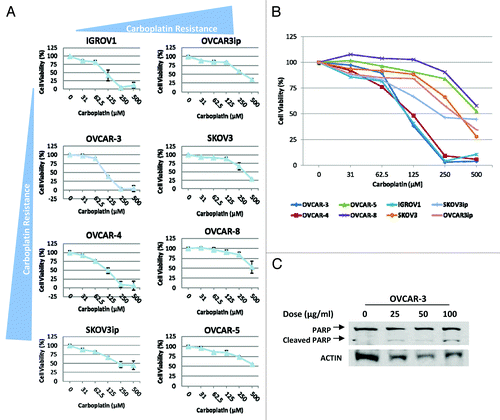
Figure 4. AT-406 sensitizes the in vitro responses of ovarian cancer cells to carboplatin. (A and B) Graphical representation of ovarian cancer cells treated with carboplatin and AT-406 as single agents, highlighting that the carboplatin resistant cell lines are concurrently sensitive to AT-406 treatment (blue, green, and pink curves). (C) The Cell viability curves of ovarian cancer cells treated with increasing doses of carboplatin in the presence or absence of the IC25 or IC50 of AT-406. *Denotes ovarian cancer cell lines in which AT-406 sensitizes the carboplatin induced cell death.
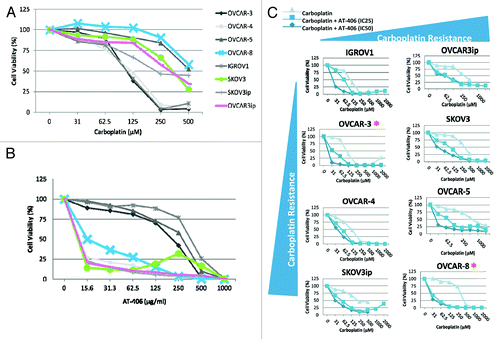
Figure 5. AT-406 displayed anti-ovarian cancer efficacy as a single agent and when used in combination with carboplatin, and prolonged survival of experimental mice. (A) Schematic representation of in vivo treatment schedule. Briefly, 5 × 106 OVCAR3ip cells were injected i.p. into a cohort of immunocompromised B6.129S7-Rag1tmMom mice. The tumors were allowed to grow for a week and these mice were then randomly divided into the following treatment groups: Control (n = 9), Carboplatin (n = 7), AT-406 (n = 5), and Combination (n = 7). These groups were treated as depicted in the schematic and the followings: Control treatment, the vehicle (200μl) by oral gavage everyday for 10 d, followed by a 3 d break, and 6 subsequent treatments for a total of 16 treatments; AT-406 treatment, AT-406 at 100 mg/kg by oral gavage as described for the vehicle treatment; carboplatin treatment, 40 mg/kg intraperitoneal injection of carboplatin twice weekly for two cycles; and the combination treatment, treating with AT-406 and carboplatin simultaneously adhering to the protocol described above for individual agents. Survival analysis was performed and mice were sacrificed when they appeared moribund or displayed signs of distress. (B) Kaplan-Meier survival curves that compare the control vehicle-treated (n = 9), carboplatin-treated (n = 7), AT-406-treated (n = 5), or AT-406 plus carboplatin-treated (n = 7) mice. Group 1 = Control, Group 2 = Carboplatin, Group 3 = AT-406, Group 4 = AT-406 plus Carboplatin. **, p > 0.005
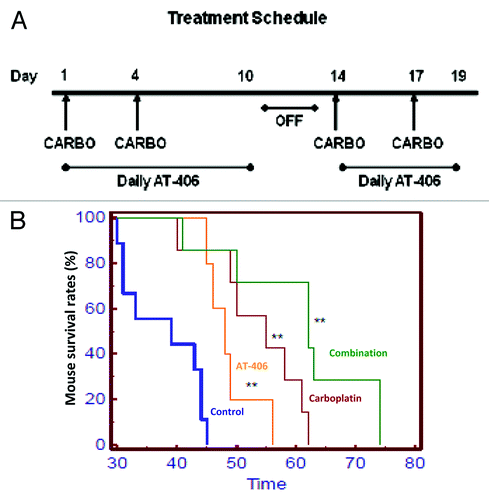
Figure 6. AT-406 reduces XIAP protein levels and induces PARP cleavage in the AT-406 sensitive but not AT- 406 resistant ovarian cancer cell lines. A-B, Ovarian cancer cells, OVCAR-3, IGROV1, OVCAR-3ip and SKOV-3, were treated with indicated amounts of AT-406 for 48 h. Cells were harvested at varying time points as indicated in the panels and probed for cleaved-PARP and XIAP. Actin was used as a loading control. C, OVCAR3 and OVCAR-3ip ovarian cancer cell lines were treated with or without AT-406 (3 μg/ml or 30 μg/ml, respectively) for 4 h. Cells treated with AT-406 were then treated with a vehicle (DMSO) or MG132 (10 μM/ml) for an additional 4 h before the cells were lysed and extracted for western blotting with anti-XIAP and cleaved-PARP antibodies.
